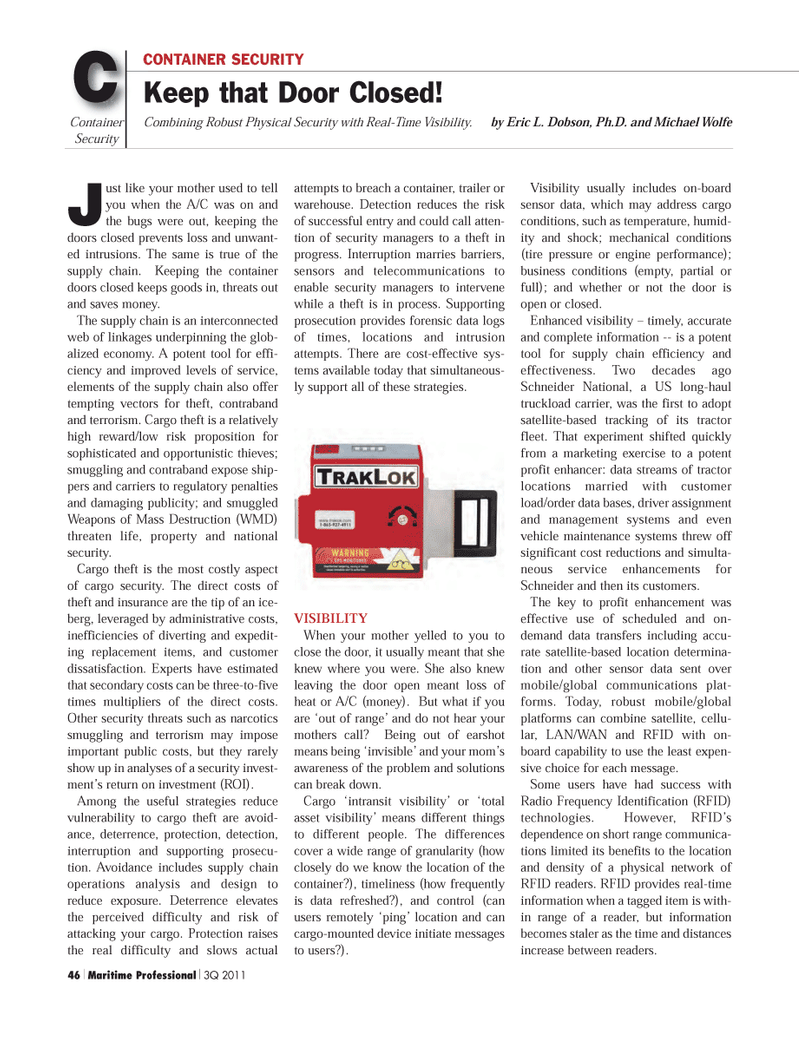
Page 46: of Maritime Logistics Professional Magazine (Q3 2011)
Maritime Security / Maritime Training & Education
Read this page in Pdf, Flash or Html5 edition of Q3 2011 Maritime Logistics Professional Magazine
46 Maritime Professional 3Q 2011CContainerSecurityKeep that Door Closed!Combining Robust Physical Security with Real-Time Visibility. by Eric L. Dobson, Ph.D. and Michael Wolfe CONTAINER SECURITY Just like your mother used to tell you when the A/C was on and the bugs were out, keeping the doors closed prevents loss and unwant- ed intrusions. The same is true of the supply chain. Keeping the container doors closed keeps goods in, threats out and saves money. The supply chain is an interconnectedweb of linkages underpinning the glob-alized economy. A potent tool for effi- ciency and improved levels of service, elements of the supply chain also offer tempting vectors for theft, contraband and terrorism. Cargo theft is a relatively high reward/low risk proposition for sophisticated and opportunistic thieves; smuggling and contraband expose ship- pers and carriers to regulatory penalties and damaging publicity; and smuggledWeapons of Mass Destruction (WMD) threaten life, property and nationalsecurity. Cargo theft is the most costly aspect of cargo security. The direct costs of theft and insurance are the tip of an ice-berg, leveraged by administrative costs, inefficiencies of diverting and expedit- ing replacement items, and customerdissatisfaction. Experts have estimated that secondary costs can be three-to-five times multipliers of the direct costs.Other security threats such as narcoticssmuggling and terrorism may imposeimportant public costs, but they rarely show up in analyses of a security invest- ment?s return on investment (ROI). Among the useful strategies reduce vulnerability to cargo theft are avoid- ance, deterrence, protection, detection,interruption and supporting prosecu-tion. Avoidance includes supply chain operations analysis and design toreduce exposure. Deterrence elevates the perceived difficulty and risk of attacking your cargo. Protection raises the real difficulty and slows actual attempts to breach a container, trailer or warehouse. Detection reduces the risk of successful entry and could call atten-tion of security managers to a theft inprogress. Interruption marries barriers,sensors and telecommunications toenable security managers to intervene while a theft is in process. Supportingprosecution provides forensic data logs of times, locations and intrusionattempts. There are cost-effective sys- tems available today that simultaneous- ly support all of these strategies. VISIBILITYWhen your mother yelled to you toclose the door, it usually meant that sheknew where you were. She also knew leaving the door open meant loss of heat or A/C (money). But what if you are ?out of range? and do not hear your mothers call? Being out of earshotmeans being ?invisible? and your mom?s awareness of the problem and solutions can break down. Cargo ?intransit visibility? or ?total asset visibility? means different things to different people. The differences cover a wide range of granularity (how closely do we know the location of the container?), timeliness (how frequently is data refreshed?), and control (canusers remotely ?ping? location and can cargo-mounted device initiate messages to users?).Visibility usually includes on-board sensor data, which may address cargo conditions, such as temperature, humid-ity and shock; mechanical conditions(tire pressure or engine performance);business conditions (empty, partial or full); and whether or not the door isopen or closed.Enhanced visibility ? timely, accurate and complete information -- is a potenttool for supply chain efficiency and effectiveness. Two decades ago Schneider National, a US long-haultruckload carrier, was the first to adopt satellite-based tracking of its tractorfleet. That experiment shifted quickly from a marketing exercise to a potent profit enhancer: data streams of tractor locations married with customerload/order data bases, driver assignment and management systems and even vehicle maintenance systems threw off significant cost reductions and simulta- neous service enhancements forSchneider and then its customers.The key to profit enhancement was effective use of scheduled and on- demand data transfers including accu-rate satellite-based location determina-tion and other sensor data sent over mobile/global communications plat-forms. Today, robust mobile/global platforms can combine satellite, cellu-lar, LAN/WAN and RFID with on- board capability to use the least expen- sive choice for each message. Some users have had success with Radio Frequency Identification (RFID) technologies. However, RFID?s dependence on short range communica-tions limited its benefits to the location and density of a physical network of RFID readers. RFID provides real-time information when a tagged item is with-in range of a reader, but information becomes staler as the time and distancesincrease between readers.MP #3 (34-49):MP Layouts 8/17/2011 4:30 PM Page 46

 45
45

 47
47
